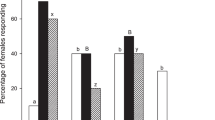Abstract
Early in spring, just after the snow melts, the leaf beetle Oreina cacaliae feeds on flowers of Petasites paradoxus. Later in spring they switch to their principle host plant Adenostyles alliariae. The attractiveness of short- and long-term damaged host plants was studied in a wind tunnel. The spring host P. paradoxus was more attractive to the beetles after it had been damaged overnight by conspecifics or artificially, but not when the plants were damaged half an hour before the wind-tunnel experiments. Contrary to P. paradoxus, the principle host plant, A. alliariae was more attractive shortly after an attack by conspecifics (half an hour before the experiment) compared to a undamaged plant, but lost its increased attractiveness when damaged overnight. The enhanced attraction of damaged plants was longer lasting in the spring host P. paradoxus than in the main host A. alliariae. Volatiles emitted by host plants were collected and gas chromatographic analyses of the odors collected showed qualitative and quantitative differences between damaged and undamaged plants. Among the volatiles recorded, green leaf volatiles and mono- and sesquiterpenes dominated. In overnight damaged P. paradoxus plants with an enhanced attractiveness, limonene was emitted in higher amounts. In freshly damaged A. alliariae leaves, more α-humulene and germacrene D were emitted compared to (E,E)-α-farnesene, whereas in the less attractive A. alliariae plants, more (E,E)-α-farnesene was emitted compared to α-humulene and germacrene D. In the field, the long lasting attraction of flowering P. paradoxus early in the season may facilitate mating in O. cacaliae after a successful overwintering.
Similar content being viewed by others
REFERENCES
BOLTER, C. J., DICKE, M. V. LOON, J. J. A. VISSER J. H., and POSTHUMUS, M. A. 1997. Attraction of Colorado potato beetle to herbivore-damaged plants during herbivory and after its termination. J. Chem. Ecol.23:1003-1023.
BORDEN, J. H. 1984. Semiochemical-mediated aggregation and dispersion in the Coleoptera, pp. 123-149, inT. Lewis (ed.). Insect Communication.Academic Press, Orlando, Florida.
DOBLER, S., and ROWELL-RAHIER, M. 1994. Production of cardenolides versus sequestration of pyrrolizidine alkaloids in larvae of Oreinaspecies (Coleoptera, Chrysomelidae). J. Chem. Ecol.20:555-568.
DOMEK, J. M., and JOHNSON, D. T. 1988. Demonstration of semiochemically induced aggregation in the green June beetle, Cotinis nitida(L.) (Coleoptera, Scarabaeidae). Environ. Entomol.17:147-149.
EGGENBERGER, F., and ROWELL-RAHIER, M. 1991. Chemical defence and genetic variation. Naturwissenschaften78:317-320.
EGGENBERGER, F., and ROWELL-RAHIER, M. 1993. Physiological sources of variation in chemical defense of Oreina gloriosa(Coleoptera: Chrysomelidae). J. Chem. Ecol.19:395-410.
EHMKE, A., ROWELL-RAHIER, M. PASTEELS J. M., and HARTMANN, T. 1991. Sequestration of ingested [14C]senecionine N-oxide in the exocrine defensive secretions of chrysomelid beetles. J. Chem. Ecol.17:2367-2379.
HARARI, A. R., BEN-YAKIR D., and ROSEN, D. 1994. Mechanism of aggregation behavior in Maladera matridaArgaman (Coleoptera: Scarabidae). J. Chem. Ecol.20:361-371.
HEATH, R. R., and MANUKIAN, A. 1992. Development and evaluation of systems to collect volatile semiochemicals from insects and plants using a charcoal-infused medium for air purification. J. Chem. Ecol.18:1209-1126.
JONES, O. T. 1985. Chemical mediation of insect behavior, pp. 311-373, in D. H. Hutson and T. R. Roberts (eds.). Progress in Pesticide Biochemistry and Toxicology, Vol. 5, Insecticides. Wiley, New York.
KALBERER, N. M. 2000. Host-plant recognition, dispersal and its influence on reproduction in the alpine leaf beetle Oreina cacaliae.PhD thesis. University of Neuchâtel, Neuchâtel, Switzerland.
LOHSE, G. A., and LUCHT, W. H. 1994. page 73, inGoecke and Evers (ed.). Die Käfer Mitteleuropas14. Krefeld.
LOUGHRIN, J. H., POTTER D. A., and HAMILTON-KEMP, T. R. 1995. Volatile Compounds induced by Herbivory act as Aggregation Kairomones for the Japanese beetle (Popillia japonicaNewman). J. Chem. Ecol.21:1457-1467.
MILLER, J. R., and STRICKLER, K. L. 1984. Finding and accepting host plants, inW. J. Bell and R. T. Cardé (eds.). Chemical Ecology of Insects.Chapman and Hall, New York. pp. 127-155.
PARE, P.W., and TUMLINSON, J. H. 1997. De novo biosynthesis of volatiles induced by insect herbivory in cotton plants. Plant Physiol.114:1161-1167.
PASTEELS, J. M., ROWELL-RAHIER, M., BRAEKMAN, J.-C., and DALOZE, D. 1994. Chemical defense of adult leaf beetles updated, pp. 298-301, inP. Jolivet, M. Cox, and E. Petitpierre (eds.). Novel Aspects of the Biology of ChrysomelidaeKluwer, Dordrecht.
PENG, C., and WEISS, M. J. 1992. Evidence of an aggregation pheromone in the flea beetle, Phyllotreta cruciferae(Coleoptera: Chrysomelidae). J. Chem. Ecol.18:875-884.
SAXENA, K., and GOYAL, N. S. 1978. Host-plant relations of the citrus butterfly Papilio demolusL.: Orientation and ovipositional responses Entomol. Exp. Appli.24:1-10.
SCUTAREANU, P., DRUKKER, B., BRUIN, J., POSTHUMUS, M. A., and SABELIS, M. W. 1997. Volatiles from Psylla-infested pear trees and their possible involvement in attracting of anthocorid predators. J. Chem. Ecol.23:2241-2260.
STEVENS, L., and CAULEY, D. E. M. 1989. Mating prior to over-wintering in the important willow leaf beetle, Plagiodera versicolora(Coleoptera: Chrysomelidae). Ecol. Entomol.14:219-223.
TAKABAYASHI, J., DICKE M., and POSTHUMUS, M. A. 1994. Volatile herbivore-induced terpenoids in plant-mite interactions: Variation caused by biotic and abiotic factors. J. Chem. Ecol.20:1329-1354.
TURLINGS, T. C. J., TUMLINSON J. H., and LEWIS, W. J. 1990. Exploitation of herbivore-induced plant odours by host-seeking parasitic wasps. Science250:1251-1253.
TURLINGS, T. C. J., BERNASCONI, M., BERTOSSA, R., BIGLER, F., CALOZ, G., and DORN, S. 1998. The induction of volatile emissions in maize by three herbivore species with different feeding habits: possible consequences for their natural enemies. Biol. Control11:122-129.
VISSER, J. H., and AVé, D. A. 1978. General green leaf volatiles in the olfactory orientation of the Colorado beetle, Leptinotarsa decemlineata. Entomol. Exp. Appl.24:538-549.
VISSER, J. H., and NIELSON, J. K. 1977. Specificity in the olfactory orientation of the CPB. Entomol. Exp. Appl.21:14-22.
VISSER, J. H., STRATEN S. V., and MAARSE, H. 1979. Isolation and identification of volatiles in the foliage of potato, Solanum tuberosuma host plant of the Colorado beetle, Leptinotarsa decemlineata. J. Chem. Ecol.5:13-25.
YAMASAKI, T., SATO, M., and SAKOGUCHI, H. 1997. Germacrene D: Masking substance of attractants for the cerambycid beetle, Monochamus alternatus(Hope). Appl. Entomol. Zool.32:423-429.
Author information
Authors and Affiliations
Rights and permissions
About this article
Cite this article
Kalberer, N.M., Turlings, T.C.J. & Rahier, M. ATTRACTION OF A LEAF BEETLE (Oreina cacaliae) TO DAMAGED HOST PLANTS. J Chem Ecol 27, 647–661 (2001). https://doi.org/10.1023/A:1010389500009
Issue Date:
DOI: https://doi.org/10.1023/A:1010389500009




